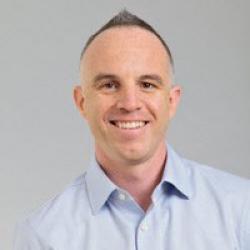Karl Huntzicker is the Global Director for Health and Safety for Salesforce. With over 20 years of experience, Karl is dedicated to building a world-class safety culture at Salesforce by leveraging technology, telling stories, and engaging employees as CAREforce ambassadors.
Michael Fleming is the Regional Manager for EMEA Health and Safety at Salesforce. He has over 15+ years of experience working in as Health & Safety professional in construction, experiential events, and now the tech sector. Salesforce graciously hosted the EHSxTech spring 2019 meeting, an exclusive gathering of industry leaders to share insights and discuss common health and safety challenges in technology organizations.
What constitutes an event? It seems like a simple question, but when it comes to health, and safety, the waters can get a bit muddy. Is it an “event” if the public will be attending? If it reaches a certain size? If particular risk factors, such as catered food service, audio visual setup, entertainment acts are present? Or does any gathering of more than a certain number of people function as an “event,” which triggers safety planning requirements?
Even after you can agree on your own organization’s definition for what a campus event is, it can be tricky to determine who is ultimately responsible for safe planning and delivery of that event—Health and Safety? Facilities? Security? The event host function? PR and Marketing? Considering that large organizations can host hundreds of events a year on their campuses, each of which have an impact on the attendees, general employees, and the organization’s brand reputation, these questions start to take on new importance.
There is a renewed interest in event safety coming out of the technology industry, where global companies host huge public-facing events (and may even have public spaces or retail facilities right on their office campuses) and are coming face-to-face with the joint responsibilities of hosting a successful event and ensuring the safety of all involved.
Mapping Event Challenges and Risks
The challenges associated with monitoring safety at large-scale on-campus events begin with the fact that many functions within the organization may be planning events with no direct line of communication to H&S. If H&S is involved at all, it can be at the last minute, and is often treated as a killjoy hall monitor rather than a partner who can give guidance on appropriate controls to enable a successful event.
With all this mind, H&S must engage with their relevant stakeholders to create a safety framework that facilitates the safe planning and delivery of an event. Events risks can generally be broken down into three categories—people, physical space, and live events:
- People-related risks to consider include medical support, the demographics of your audience (children, the elderly, people who are ability impaired, VIPs or celebrities, etc.), fire safety, event security, crowd capacity, and crowd management.
- Physical space risks to consider include infrastructure (such as stages or other temporary structures), electrical needs, contractor safety, local authority licensing permits and permissions, event space accessibility, and mobility.
- Live event risks could include entertainment (musicians, a petting zoo, a magician, etc.), food safety, crowd flow, event team communication, reputational risk, and crisis planning.
You may have policies in place for many of these risks during the course of normal business operations on campus. The question to ask yourself is: how are they applied, actioned, and monitored in the context of an event?
It is critical that you as an organization look at your on-campus events and fully understand the associated risks. As part of this effort, you should also understand the control measures you will need to implement.
Event Planning and Preparation
Once you understand what constitutes an event for your organization and identify the risks and required controls, it is time to create a safety framework to support effective event delivery. Including health and safety as part of the overall event planning process will enable the event teams to provide a safe and successful event.
Event safety planning activities can be broken down into three progressive steps: creating an overall event safety standard, pre-event planning, and event delivery.
- Event safety standard: Before concerning yourself with an individual event, you want to set up your overarching approach to event safety. Major action items here include defining safety roles and responsibilities during an event, providing training to employees taking on these responsibilities, agreeing on a defined event planning and approval process, and communicating that process to all stakeholders.
- Pre-event planning: It’s time to put the processes you developed into action. During this phase you should be implementing the control measures you have identified. This is also the time to ensure you have done an event-specific risk assessment, including the planned event site, set-up, emergency response plan, and any license approvals.
- Event delivery: After building safety into the event planning process upfront, now it’s time to plan for it during the event itself. Determine how the event will be monitored, ensure competent and trained event staff are in place, maintain clear lines of communication, and have a response plan in place. Make sure all impacted groups clearly understand their roles.
H&S as Event Partner
With the basics covered, it’s time to position H&S as a partner in creating successful events. This is an opportunity to showcase your work as a facilitator who helps deliver successful events, as opposed to a blocker. One simple way to do this is by making things easy for the rest of the organization—consider providing easy-to-understand role descriptions, a responsibility flow chart, and quick-reference guides (e.g., if you know an event will require external medical support, have a referral and pricing information ready to go.) You may find that internal stakeholders are relieved to have the guidance! Automating tasks when possible and partnering closely with your facilities or real estate teams can help scale your efforts across the organization.
H&S can also proactively offer input on proposed campus event and facility design work, helping to ensure event safety is factored into campus use rather than requiring a retrofitted solution.
Risks and Rewards
Events can form an important part of a brand’s identity and public presence, but they also represent potential exposure to risks which can affect attendees, the event facility and, by extension, the company’s reputation and bottom line. However, by working collaboratively to understand the challenges and develop a clearly defined safe-work process, H&S can influence and guide stakeholders to deliver safe and successful events.
Read more about our EHSxTech events and takeaways.
Want more news and insights like this?
Sign up for our monthly e-newsletter, The New Leaf. Our goal is to keep you updated, educated and even a bit entertained as it relates to all things EHS and sustainability.
Get e-NewsletterAbout the Authors

Karl Huntzicker
Global Director for Health and Safety at Salesforce
Karl Huntzicker is the Global Director for Health and Safety for Salesforce. With over 20 years of experience, Karl is dedicated to building a world-class safety culture at Salesforce by leveraging technology, telling stories, and engaging employees as CAREforce ambassadors.

Michael Fleming
Regional Manager for EMEA Health and Safety at Salesforce
Michael Fleming is the Regional Manager for EMEA Health and Safety at Salesforce. He has 15+ years of experience working in as Health & Safety professional in construction, experiential events, and now the tech sector.




